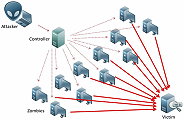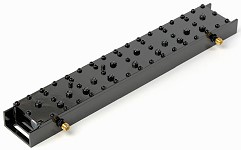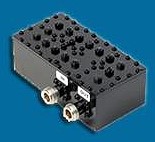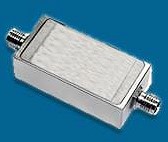Anatech Electronics February 2019 Newsletter |
||

Press Release Archives: 2024 | 2023 | 2022 | 2021 |2020 2019 | 2018 | 2017 | 2016 | 2015 2014 | 2013 | 2012 | 2011 | 2010 2009 | 2008 | 2007 | 2006 | 2005 Content is copyright of company represented. Page format, custom text and images are RF Cafe copyright - do not distribute.
Sam Benzacar, of RF and microwave filter company Anatech Electronics, has written as part of his February newsletter this piece entitled, "'Mysterious' Cuban U.S. Embassy Weapon: It Wasn't Crickets." Sam keeps abreast of all the latest news in the wireless world, which is not unexpected given his company's long-time involvement in helping others make their products play well together in an increasingly crowded electromagnetic spectrum - both licensed and unlicensed. Beginning in late 2016, news reports detailed how many U.S. and Canadian embassy staffers and their families told of hearing strange sounds in their heads and experiencing nausea and headaches*. Of course no conclusive evidence as to the source has ever been discovered since officials of the western hemisphere's only Communist nation (Cuba) allows only limited access to investigators. Specially modulated microwave or sonic radiation is still the suspected method according to many researchers, although some sources are quick to name the obvious culprit: Donald Trump (who was not president at the time, see end of article). * see Hearing Microwaves - It's All in Your Head A Word from Sam Benzacar  "Mysterious" Cuban U.S. Embassy Weapon: It Wasn't Crickets By Sam Benzacar There seems to be no limit to how weird the investigation into the mysterious illnesses suffered by U.S. and Canadian diplomats and their families in Cuba can become, and how limited in scope the report resulting from the investigation turned out to be. As you may remember, late in 2016 diplomats headquartered at the U.S. embassy in Havana began reporting health effects including cognitive impairment, hearing loss, tinnitus, strange sounds, headaches, insomnia, blurred vision, balance and speech problems, and even nosebleeds. Some of these people continue to experience what may be life-long effects. The events occurred not just in the embassy but in hotel rooms and homes, as well. Somewhat later, 14 "employees, spouses and dependents" who were either stationed at or visited the Canadian embassy began to experience similar problems, and last month Canada reduced its staff by half. In an attempt to solve the mystery, a team of researchers from the University of Pennsylvania performed a preliminary evaluation of 21 people identified by the State Department as having been exposed. No firm conclusions as to the source were determined. And just a few weeks ago, biologist Alexander Stubbs from the University of California, Berkeley, after hearing a recording made available by the Associated Press of what some embassy workers heard, came to another conclusion: bugs. Yes, bugs. Stubbs and colleague Fernando Montealegre-Z, an expert on entomological acoustics, searched a database of insert recordings and found that the Indies short-tailed cricket makes a sound almost identical to what is on the recording. Both the recording and the offending sounds were emitted at 7 kHz with a repetition rate of 180 pulses per second, lowering in pitch as they decrease in amplitude. However, the cricket sounds, and the AP recording didn't entirely match, as the pulses in the recording were more erratic. Stubbs chalks that up to echoing from surfaces in an indoor space. So, he played the sounds indoors and they matched perfectly. Case solved, right? Nope. This and the other theories have been cast aside and microwave energy is now considered the most likely source (even the U Penn study's lead author has become a believer), which would have been my first conclusion and I suspect that of many readers of this column. The U Penn researchers concentrated on sonic or ultrasonic sources, as many of the reported symptoms were related to hearing, and even viral infections, and "contagious anxiety." There is no mention in the report of RF and microwave energy, and it was never even considered. Second, this is hardly the first time microwave energy has been used by another country for nefarious purposes --the Russians have been using it for many years In 1976 it caused a major incident when the U.S. complained that the Russians had been irradiating the U.S. Embassy in Moscow at between 2.5 and 4 GHz since 1953, causing health effects. In addition to Cuba, the Russians are apparently still at it, as a USAID offer reported health effects in Uzbekistan in 2017. Although microwave radiation will cause damage to tissues, and especially the eyes, when exposed to high-levels of non-ionizing (i.e., microwave) radiation, the cause this time is presumably the microwave auditory effect, also called the "Frey Effect," which causes the perception of audible clicks or even speech induced by pulsed or modulated RF, and at higher levels significant health effects. It was first reported by people working near radars during World War II and first reported publicly in 1961 by American neuroscientist Allan H. Frey. It causes similar or possibly identical effects as those reported in Cuba, Russia, and China. So, what's to make of this? A cynical person might suggest that the Department of Defense, which is well aware of the Frey Effect and may also use it, might be tight-lipped. However, from a microwave technology perspective, the fact that microwave energy was never considered by the researchers who according to Smith were "very skeptical at first" when finally concluding the microwave energy was the prime suspect, is sad indeed. A little historical background goes a long way. As George Santayana famously noted: "Those who do not remember the past are condemned to repeat it."
AT&T is continuing attempts to bail itself out after referring to its latest advances in cellular deployment as 5G Evolution and putting "5G E" in the status bar atop smartphone screens operating on its network. Sprint's just took compliant to the next level, filing a lawsuit claiming that "AT&T has employed numerous deceptive tactics to mislead consumers into believing that it currently offers a coveted and highly anticipated fifth-generation wireless network, known as 5G. What AT&T touts as 5G, however, is nothing more than an enhanced fourth-generation Long Term Evolution wireless service, known as 4G LTE Advanced, which is offered by all other major wireless carriers." Which in fact it is.
Ubiquiti Networks is working to fix a security issue affecting its devices that attackers have been exploiting since July. The issue impacts more than 485,000 devices, according to an internet scan conducted by cybersecurity firm Rapid7. Hackers have been using a service running on port 10,001 on Ubiquiti devices to carry out weak DDoS amplification attacks. The attackers are sending small packets of 56 bytes to port 10,001 on Ubiquiti devices, which are relaying the packets to a target's IP address amplified to 206 bytes, causing overload.
The ITU has reported that new ITU standards will allow high-speed broadband services to be delivered in rural communities using lightweight optical cable that can be laid on the ground at a fraction of the cost of typical fiber deployment. This, is says, can give developing countries the ability to optical networks in remote regions served, if at all, by satellite, whose latency is too high for medical and other applications. Nepal, for example, intends to use ITU-standardized lightweight optical cable to connect places as remote as Mount Everest Base Camp and Annapurna Trekking Trail.
A system called LiFiMAX uses lightwaves to deliver a 100 Mb/s downlink data rate and 40 Mb/s uplink rate and can serve up to 16 people at once. This innovation coms from Oledcomm, which introduced its My LiFi lamp for homes that provides Internet access as well as the ability to change the intensity of the light depending on the time of day. The transmitter goes into the false ceiling of a room like a spotlight or can mount on the ceiling, and is about the size of a smoke detector. Users have USB dongles connected to their devices that convert the light signals into data. Anatech Electronics Introduces a New Line of Suspended Stripline and Waveguide Type RF Filters
Check out Our Filter Products
Cavity Band Pass Filters LC Band Pass Filters Cavity Bandstop/Notch Filter About Anatech Electronics Anatech Electronics, Inc. (AEI) specializes in the design and manufacture of standard and custom RF and microwave filters and other passive components and subsystems employed in commercial, industrial, and aerospace and applications. Products are available from an operating frequency range of 10 kHz to 30 GHz and include cavity, ceramic, crystal, LC, and surface acoustic wave (SAW), as well as power combiners/dividers, duplexers and diplexers, directional couplers, terminations, attenuators, circulators, EMI filters, and lightning arrestors. The company's custom products and capabilities are available at www.anatechelectronics.com. Contact: Anatech Electronics, Inc. 70 Outwater Lane Garfield, NJ 07026 (973) 772-4242
Posted February 21, 2019 |
||

 AT&T's "5G E" Blunder Gets Ugly(er)
AT&T's "5G E" Blunder Gets Ugly(er) Security Problem Hits Ubiquiti Devices
Security Problem Hits Ubiquiti Devices Broadband Coming to the Most Remote Places
Broadband Coming to the Most Remote Places Li-Fi
Gains Traction
Li-Fi
Gains Traction



